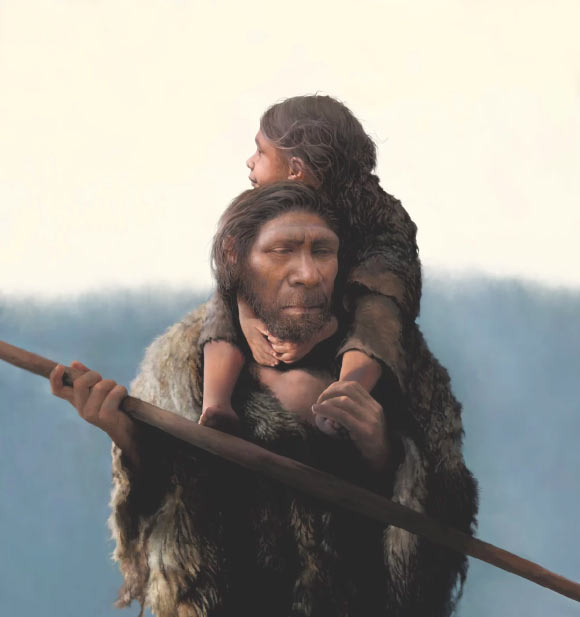Paleoanthropologists have explored the social organization of Neanderthals using ancient nuclear, Y-chromosomal and mitochondrial DNA data from the remains of 13 individuals recovered from two sites — Chagyrskaya and Okladnikov caves — in the Altai Mountains of southern Siberia.
Neanderthals occupied western Eurasia from around 430,000 years ago until their extinction around 40,000 years ago.
Genome-scale data have been reported for the skeletal remains of 18 individuals from 14 archaeological sites spanning Neanderthal history across large parts of their known geographical range, which extends as far east as the Altai Mountains in southern Siberia.
These data have yielded a broad overview of Neanderthal populations, indicating the existence of multiple distinct Neanderthal populations over time and space.
However, little is known about the genetic relationships and social organization within and between Neanderthal communities in any part of Eurasia during this time interval.
“By social organization, we mean the size, sex composition and spatiotemporal cohesion of a community,” said first author Dr. Laurits Skov from the Max Planck Institute for Evolutionary Anthropology and colleagues.
“We define a community as a set of individuals that presumably lived together at the same location, and reserve the term population for a broadly connected set of communities in a wider geographical area.”
In their study, the researchers analyzed genetic data of 11 Neanderthals from Chagyrskaya Cave and two from Okladnikov Cave, two Middle Paleolithic sites located close to one another in southern Siberia.
The data came from 7 men and 6 women, of which 8 were adults and 5 were children and young adolescents.
“Neanderthals briefly occupied these sites around 54,000 years ago, and multiple potentially contemporaneous Neanderthal remains had been recovered from their deposits,” the authors said.
“These Neanderthals hunted ibex, horses, bison and other animals that migrated through the river valleys that the caves overlook.”
“Archaeologists collected raw materials for their stone tools dozens of kilometers away, and the occurrence of the same raw material at both Chagyrskaya and Okladnikov caves also supports the genetic data that the groups inhabiting these localities were closely linked.”
In the mitochondrial DNA of these Neanderthals, the scientists found several so-called heteroplasmies that were shared between individuals.
“Heteroplasmies are a special kind of genetic variant that only persists for a small number of generations,” they explained.
Among these Neanderthals were a father and his teenage daughter as well as a pair of second degree relatives — a young boy and an adult female, perhaps a cousin, aunt or grandmother.
The combination of heteroplasmies and related individuals strongly suggests that the Neanderthals in Chagyrskaya Cave must have lived at around the same time.
“The fact that they were living at the same time is very exciting,” Dr. Skov said.
“This means that they likely came from the same social community.”
“So, for the first time, we can use genetics to study the social organization of a Neanderthal community.”
Another striking finding is the extremely low genetic diversity within this Neanderthal community, consistent with a group size of 10 to 20 individuals.
This is much lower than those recorded for any ancient or present-day human community, and is more similar to the group sizes of endangered species at the verge of extinction.
“However, Neanderthals didn’t live in completely isolated communities,” the authors said.
“By comparing the genetic diversity on the Y-chromosome, which is inherited father-to-son, with the mitochondrial DNA diversity, which is inherited from mothers, we could answer the question: Was it the men or the women who moved between communities?”
“We found that the mitochondrial genetic diversity was much higher than the Y-chromosome diversity, which suggests that these Neanderthal communities were primarily linked by female migration.”
“Despite the proximity to Denisova Cave, these migrations do not appear to have involved Denisovans — we found no evidence of Denisovan gene flow in the Chagyrskaya Neanderthals in the last 20,000 years before these individuals lived.”
“Our study provides a concrete picture of what a Neanderthal community may have looked like,” said senior author Dr. Benjamin Peter, also from the Max Planck Institute for Evolutionary Anthropology.
“It makes Neanderthals seem much more human to me.”
The team’s results were published in the journal Nature.
_____
L. Skov et al. 2022. Genetic insights into the social organization of Neanderthals. Nature 610, 519-525; doi: 10.1038/s41586-022-05283-y








